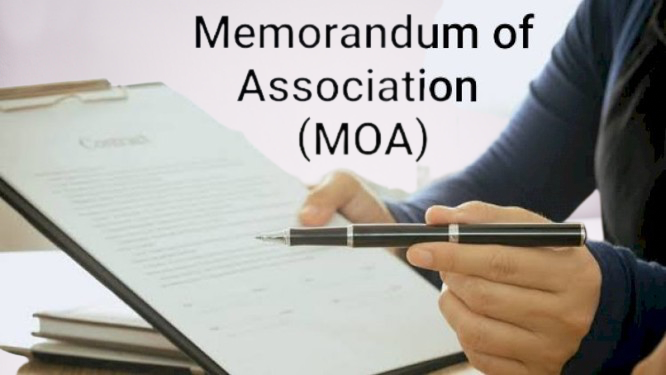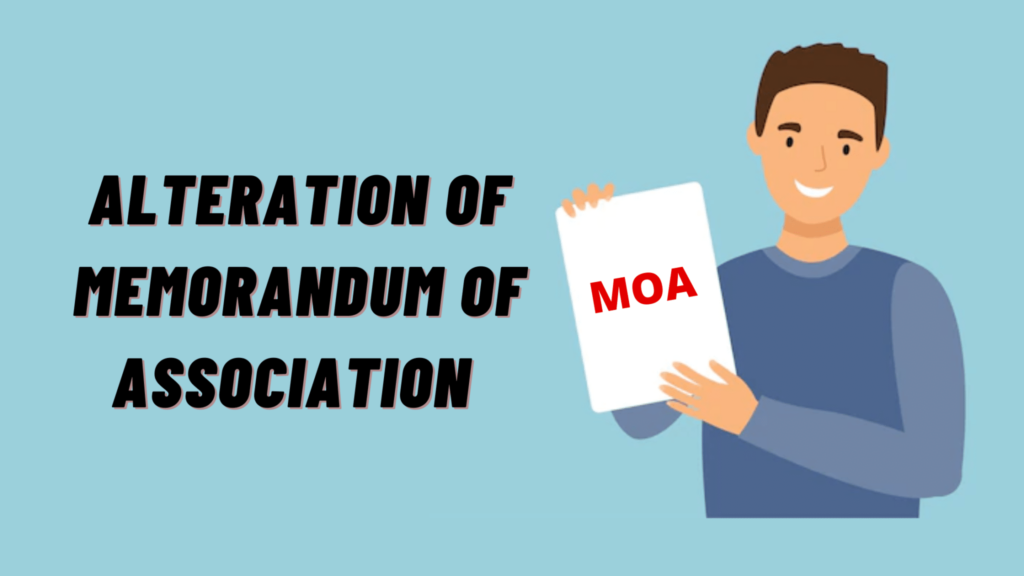The organisation’s objectives, activities, and associations with investors and the rest of the world are completely spread out in this central report. However, the initial MOA may need to be modified to accommodate new strategies, expansions, or regulatory changes due to the constantly shifting business environment.
Memorandum of Article is a vital document for the Company, which provides the Scope, objectives, and limitations of it. It lays down the framework within which the company operates, and any changes to the MOA can have far-reaching consequences for the company and its stakeholders. An alteration of the MOA may become necessary due to various reasons, such as changes in the company’s business model, expansion plans, or legal requirements. The Companies Act, 2013 provides for the alteration of the MOA, subject to the approval of the shareholders and the Registrar of Companies (ROC). In this article, we will discuss the step-by-step procedure for Alteration of Memorandum of Association (MOA), documents required, clauses mentioned under MOA and many other.
the company may have to alter the specifications of its Memorandum of Association. Defining the word ‘alter’ or ‘alteration’, Section 2(3) of the Act states that it includes the making of additions, omissions, and substitutions. For instance, when the company shifts its principal office to some other location, the Registered Office Clause of the company’s Memorandum of Association will have to be altered. Nevertheless, such alteration cannot be done without satisfying the steps mandated under the provisions of the Companies Act, 2013 . In this article, we shall understand the process of altering the contents of a Memorandum of Association.

Brief about Memorandum of Association
Memorandum of Association is like the identity card of any company.
It is a document drafted before incorporating any company. It is a public document prepared by the promoters of the company. A Memorandum of Association is also called the ‘charter of the company’ and specifies the affiliation between the company and its shareholders or creditors. The entire structure of any company depends upon the Memorandum of Association. It marks the scope of a company’s operation. It means that the company must function only as per the provisions of its Memorandum of Association.
MOA is a legal document that defines the constitution and scope of a company’s activities. It contains the fundamental rules and regulations that govern the company’s affairs and sets out the company’s objectives, powers, and limitations. The MOA is a critical document that forms the basis for the company’s relationship with its shareholders, creditors, and other stakeholders. It is also required for the incorporation of a company and must be registered with the Registrar of Companies (ROC) at the time of incorporation.
The MOA must be drafted and executed in accordance with the provisions of the Companies Act, 2013, and any amendments thereto. Any alteration to the MOA must also comply with the provisions of the Act and require the approval of the shareholders and the ROC.
Clauses mentioned under MOA
The MOA is like a treasure chest of clauses, each holding a key piece of information. From the company’s name and registered office to the objects it pursues and the liability of its members, it’s all there. These clauses aren’t just legal jargon; they’re the heartbeat of your company.
1.Name Clause: The name clause outlines the name of the company and specifies whether it is a public or private company.
2.Registered Office Clause: This clause states the registered office of the company. That is the official address of the company and where all official communications and notices will be sent.
3.Liability Clause: The liability clause outlines the liability of the members of the company. In the case of a company limited by shares; the liability of the members is limited to the amount unpaid on their shares. In the case of a company limited by guarantee, the liability of the members is limited to the amount they have agreed to contribute to the company’s assets.
4.Association Clause: This clause confirms the intention of the subscribers to form the company and become its members.
5.Capital Clause: The capital clause outlines the company’s authorised share capital. This is the maximum amount of share capital the company is authorised to issue.
6.Objective Clause: This clause defines the main objectives and scope of the company’s activities. It also outlines the objects that the company is authorized to pursue and the activities that it is not authorized to undertake.

When is alteration of a Memorandum of Association allowed?
Alteration of a MOA is allowed in the following circumstances:
- Change in Objectives: If a company wants to change its objectives or expand its business activities, it may need to alter its MOA to reflect the new objectives or activities.
- Change in Name: If a company wants to change its name, it must alter its MOA to reflect the new name.
- Change in Registered Office: If a company wants to change its registered office from one state to another, it must alter its MOA to reflect the new address.
- Change in Authorized Share Capital: If a company wants to increase its authorized share capital, it must alter its MOA to reflect the increase.
- Any other change required by law: The Companies Act, 2013, or any other law may require a company to alter its MOA to comply with the legal requirements.
Documents needed for Alteration of MOA
- Notice of the General Meeting: A notice of the general meeting of the company, along with an explanatory statement, must be sent to all the shareholders of the company.
- Draft Resolution: A draft resolution proposing the alteration of the MOA must be prepared and included in the notice of the general meeting.
- Altered MOA: The altered MOA, with the proposed changes clearly highlighted or underlined, must be prepared and circulated to the shareholders.
- Board Resolution: A board resolution must be passed by the board of directors of the company approving the proposed alteration of the MOA.
- Shareholders’ Resolution: A special resolution must be passed by the shareholders of the company approving the proposed alteration of the MOA.
- Minutes of the General Meeting: Minutes of the general meeting of the company must be prepared, signed by the chairman of the meeting, and filed with the Registrar of Companies (ROC).
- Form MGT-14: Form MGT-14, which is a notice of a resolution passed by the company, must be filed with the ROC within 30 days of passing the resolution.
- Any other document as required by the ROC: The ROC may require additional documents to be submitted along with the application for the alteration of the MOA, depending on the type of alteration being made.
Procedure for alteration to memorandum of association
Step 1: Drafting the Special Resolution-The first step is to draft a special resolution proposing the alteration of the MOA. The resolution must be drafted under the provisions of the Companies Act, and the Board must approve its Directors. The resolution should specify the proposed alteration and the reason for it.
Step 2: Notice of General Meeting
The company must give notice of the general meeting to all the members of the company. The notice must specify the purpose of the meeting, which is to consider and pass the special resolution to alter the MOA. The notice must be sent at least 21 days before the date of the meeting.
Step 3: Hold the General Meeting
The general meeting must be held on the date and time specified in the notice. The members must be allowed to discuss the proposed alteration and ask questions. The special resolution must be passed by a majority of not less than three-fourths of the members present and voting.
Step 4: Filing Forms with the Registrar of Companies.
After passing the special resolution, the company must file the following forms and documents with the Registrar of Companies within 30 days of passing the resolution:
- Form MGT-14: This form is used to file the special resolution with the Registrar of Companies.
- Altered MOA: A copy of the altered MOA must be filed along with Form MGT-14.
- Payment of Fees: The company must pay the necessary fees for filing the forms and the altered MOA.
Step 5: Approval by the Registrar of Companies
The Registrar of Companies will examine the forms and the altered MOA filed by the company. If the forms and the MOA are in order and comply with the provisions of the Companies Act, the Registrar will approve the alteration. The alteration takes effect from the date of approval by the Registrar.
Step 6: Updating Company Records
The company must update its records, including the register of members, register of directors, and other statutory registers, to reflect the alteration.
The company must also notify all its stakeholders, including creditors, shareholders, and regulatory authorities, about the alteration.
Alteration Of A MOA of a company is a significant process that requires careful consideration and adherence to legal provisions.
It is always advisable to allocate professionals’ help when dealing with MOA alterations.
Due to the complex legal framework involved, companies may lack the knowledge to ensure a streamlined process.
FAQs (Frequently Asked Questions)
Q: Is alteration a must for every business?
A: Not necessarily. If your business is sailing smoothly with the current MOA, there might not be a need for a radical change. Alteration is more like a tool in your toolbox – use it when the situation demands.
Q: What's the biggest alteration success story in corporate history?
It’s a classic tale of adaptation, showing that even giants can pirouette into new directions successfully.
Q: Is alteration a one-time affair, or can I do it multiple times?
A: While it’s not a daily ritual, alterations are not a one-hit wonder either. You can make changes as needed, but each alteration should be justified and comply with legal requirements
Practice area's of B K Goyal & Co LLP
Income Tax Return Filing | Income Tax Appeal | Income Tax Notice | GST Registration | GST Return Filing | FSSAI Registration | Company Registration | Company Audit | Company Annual Compliance | Income Tax Audit | Nidhi Company Registration| LLP Registration | Accounting in India | NGO Registration | NGO Audit | ESG | BRSR | Private Security Agency | Udyam Registration | Trademark Registration | Copyright Registration | Patent Registration | Import Export Code | Forensic Accounting and Fraud Detection | Section 8 Company | Foreign Company | 80G and 12A Certificate | FCRA Registration |DGGI Cases | Scrutiny Cases | Income Escapement Cases | Search & Seizure | CIT Appeal | ITAT Appeal | Auditors | Internal Audit | Financial Audit | Process Audit | IEC Code | CA Certification | Income Tax Penalty Notice u/s 271(1)(c) | Income Tax Notice u/s 142(1) | Income Tax Notice u/s 144 |Income Tax Notice u/s 148 | Income Tax Demand Notice
Company Registration Services in major cities of India
Company Registration in Jaipur | Company Registration in Delhi | Company Registration in Pune | Company Registration in Hyderabad | Company Registration in Bangalore | Company Registration in Chennai | Company Registration in Kolkata | Company Registration in Mumbai | Company Registration in India | Company Registration in Gurgaon
